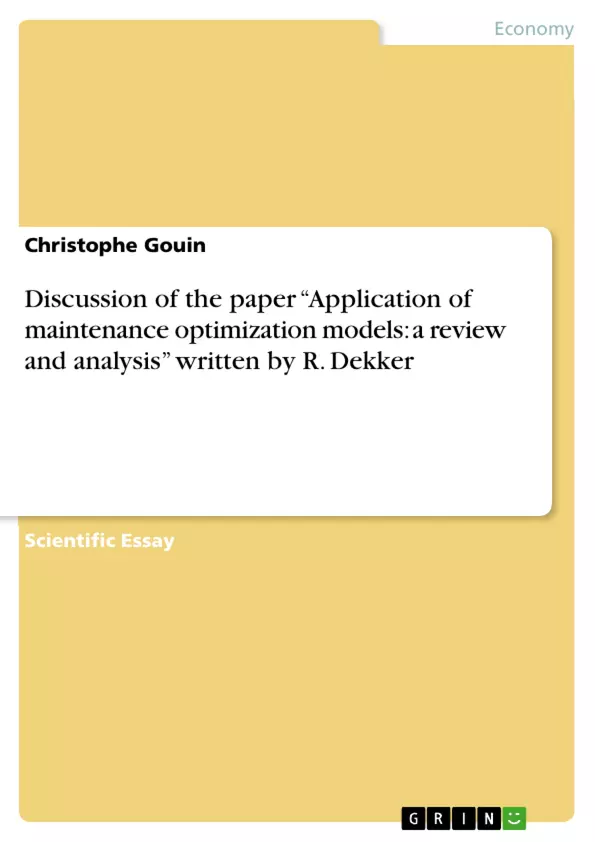Maintenance management and optimization of maintenance is getting more and more important for a large number of companies. The use of automated machines and equip-ment in order to produce goods is very common today; hence companies have to rely on reliable machines which are available and working 100% of the time. In order to attain a flawless working factory, maintenance management is crucial. However companies cannot hope that the decisions they make concerning maintenance management are optimal and they start therefore to use decision support systems based on optimization methods. Also maintenance management is very complex and a lot of different decisions have to be made, like defining maintenance intervals, personal planning, when to buy spare parts, when to replace equipment etc. It is easier for companies to base their decisions on a mathematical program, and therefore the use of maintenance management optimization models arises. Optimization models proved to be very advantageous in other sectors, so it was just a matter of time before optimization methods where ported to maintenance man-agement. Problematic in the case of maintenance optimization are the very specific maintenance problems resulting in a large number of different maintenance optimization models. It is consequently very difficult to get a good overview about the different models and their application.
R. Dekker, who has worked a lot on maintenance optimization and on operations research in maintenance management wrote a paper about maintenance optimization methods and their application, ‘Application of maintenance optimization models: a review and analysis’. It summarizes maintenance management in general, gives a brief history of maintenance management, describes different optimization methods, their practical application, problems which can occur by applying the models etc.
In this paper, I will discuss the work of R. Dekker; first of all there will be a description of the paper, explaining what it is about and giving a resume of important aspects. In the second section, the paper will be compared to other papers concerning maintenance opti-mization, different and identical aspects will be explained. Furthermore some information will be added in order to simplify the comprehension of maintenance optimization mod-els. Finally I will comment the paper, and give my opinion about the aspects that I liked and what I would describe differently.
Inhaltsverzeichnis (Table of Contents)
- Introduction
- Description of the paper
- Maintenance Management
- Maintenance optimization models
- A review of the applications
- Problems in applying optimization models
- Problems with decision support system
- Problems with data
- The gap between theory and practice
- Comparison of the paper
- Comment
- Conclusion
Zielsetzung und Themenschwerpunkte (Objectives and Key Themes)
The paper, "Application of maintenance optimization models: a review and analysis," by R. Dekker, aims to provide an in-depth overview of maintenance optimization models and their application in real-world contexts. It explores the historical development of maintenance management, the complexities of applying optimization models, and the challenges faced in bridging the gap between theory and practice.
- The importance of maintenance management in ensuring efficient and reliable operations within companies.
- The use of operations research and optimization models as tools for improving maintenance decisions.
- The challenges of applying optimization models in maintenance, including data collection problems and the gap between theoretical concepts and practical implementation.
- The significance of considering maintenance from the initial design phase of a project to optimize its life-cycle cost.
- The need for a more comprehensive understanding of the benefits and limitations of maintenance optimization models in real-world settings.
Zusammenfassung der Kapitel (Chapter Summaries)
The paper begins by defining maintenance management and its various objectives. It highlights the role of maintenance in ensuring system functionality, longevity, safety, and human well-being. The chapter then delves into the challenges of applying optimization models in maintenance, such as the difficulties in quantifying maintenance benefits and the need to integrate maintenance decisions with broader business goals.
The next section explores different types of maintenance optimization models and their advantages in improving decision-making related to maintenance intervals, personnel planning, spare part procurement, and equipment replacement. The paper also discusses the practical applications of these models in various industries.
The final section focuses on the problems encountered when applying optimization models in real-world scenarios. It examines the challenges associated with data collection, the gap between theoretical models and practical implementation, and the need for better communication and collaboration between maintenance professionals and operations researchers.
Schlüsselwörter (Keywords)
The paper revolves around the keywords: maintenance management, optimization models, operations research, reliability management, decision support systems, data collection, practical applications, gap between theory and practice, and life-cycle costing.
- Quote paper
- Christophe Gouin (Author), 2011, Discussion of the paper “Application of maintenance optimization models: a review and analysis” written by R. Dekker, Munich, GRIN Verlag, https://www.grin.com/document/172087



